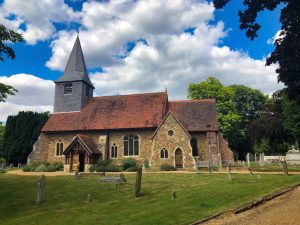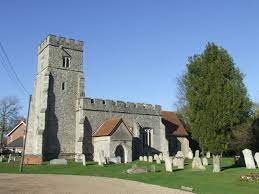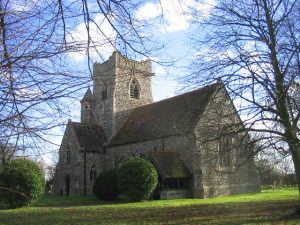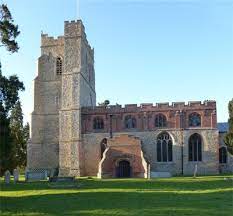It seems to be a very popular blog when I write about the villages and churches we have visited whilst sweeping for the Dioceses of Chelmsford. So, for this week’s blog here are some more of the beautiful medieval churches we have visited, this time in around central Essex. So as with all the work we do for the Bishop of Chelmsford, there was lots of driving involved! But this does mean that we get to see lots of the beautiful Essex countryside and some fantastic historic monuments in the churches themselves. What’s not to like!
St Peter’s Church Great Totham
The two questions most frequently asked about the church are: how old is it? and why is it so far from the village? The second question is easier to answer than the first. Like most English parish churches, St Peter’s would have been built by the Lord of the Manor as his private chapel, and after a few years would have been given to a monastery as a form of charitable donation. So the church is next to the Hall, with the vicarage, which perhaps stands on the site of the original priest’s house, forming a third in the group. No doubt there were a number of cottages round about, but these have left no trace. Over the years the centre of the village has shifted to busier parts of the parish, notably the crossroads where the village shop now is; but the church still stands at the geographical center of the parish, linked to all corners of it by footpaths. This would have been a gradual development; there is no reason to suppose that it was the result of a sudden single event like the Black Death.

The church’s early origins help us to understand how long it is has been here, because we know that between 1181 and 1186 it was granted to the Nunnery of St Mary Clerkenwell by Maurice de Totham; so there has been a church here since at least 1186. The earliest recorded vicar was called Thomas who, in 1285, was charged with killing Simon Godyng at Havering. He and his accomplice, the vicar of Goldhanger, were imprisoned in Newgate. The actual building, however, is less easy to date. Most churches were rebuilt at least once in the Middle Ages, or extended so much at different times that little of the original structure was left. Frederic Chancellor, writing about the church in the 19th century, thought that some of the stones at the south-east corner of the chancel were Norman, but other authorities say they are 13th century. The south wall of the nave and the base of the tower are 14th century; that is the date of the middle window in the south wall (which was originally in the chancel), and the tower window, as well as of the church’s two piscinas (one in the chancel, one in the south wall of the nave). Much of the timberwork of the nave and chancel roofs belongs to the 15th century, and the large south window to the early 16th, although its stained glass, by Powell & Son, dates from 1913.
The present appearance of the church, as with so many, is largely the result of work that was carried out in the 19th century. First, in 1878-9, the north aisle was added, to provide additional seating; this was to replace the galleries that had earlier been built in the church (probably in 1826). At the same time the architect, Joseph Clarke, rebuilt the tower and the south porch, provided new furnishings and fittings (including the seating, pulpit and font) and generally overhauled the structure. A new ring of six bells, cast by John Warner & Sons and reusing the church’s two remaining pre-Reformation bells, was hung at the same time. Further additions were made in 1881-5: the organ chamber and vestry on the north side of the chancel, and the private pew of the De Crespigny family on the south side. The architect for this work was the Revd Ernest Geldart, rector of Little Braxted, who also designed the unusual clock inside the church, as well as the east window, which was made by Cox, Sons, Buckley & Co. The private pew, which has its own outside door, contains a large number of monuments to members of the De Crespigny family, who lived at Champion Lodge (now Totham Lodge care home). The large extension on the north side of the church was added in 1990, designed by Carden & Godfrey. The stained glass window at the entrance to the extension was installed in 1995, and was made by Rowland and Surinder Warboys.
As well as the features already mentioned, there are a number of other items of interest to look out for when visiting the church. On the south side of the nave, at the east end, is a fragment of the rood screen that would have crossed the nave at this point and marked the division between the nave and chancel. There is no record of it, and it was probably taken down at the Reformation. Evidence of stairs that led up to the rood loft on top of the screen survived until the north aisle was built in 1878. Above the pulpit on the north side are three fragments of plaster that carry traces of 15th-century painting. Now very indistinct, it is said to have depicted adoring angels and archangels. In the north aisle is a rubbing of a memorial brass to Elizabeth Coke (died 1606) and her daughter, also Elizabeth; they both came to live in Great Totham in 1599. The brass itself is at the foot of the sanctuary step, but is mostly hidden by the choir stalls and carpet. By the font is a painting of the Adoration of the Magi, which hung behind the altar until the present reredos was installed in 1949. Little is known about it except that it was given by Mrs Frances Lee of Maldon and is said to have come from the chapel at Messing House. Finally, notice two depictions of St Peter, the church’s patron saint. The first is in the stained-glass window on the south side of the chancel, dated 1878, and shows him holding the keys of Heaven. The second is the statue on the outside wall of the vestry. The keys can be seen here also, on the cover of the book he has in his right hand, but in his left hand he is holding a fish – a reminder that he was a fisherman before becoming a ‘fisher of men’.

St Nicholas Church Tolleshunt D’Arcy
The rather large village of Tolleshunt D’Arcy is found lying close to the Blackwater Estuary. The church is located on the village high street. The present church was largely built between 1380 and 1420. The two St Nicholas churches (Tolleshunt D’Arcy and Tolleshunt Major) now form the Benefice of Tolleshunt D’Arcy. This Grade I listed building is made of ragstone from Maidstone, Kent, rather than the more usual flint. The nave and tower are 14th century, the chancel, south porch and north chapel all 15th century. The floor of the bell chamber is original. Internally, there are several well preserved brasses (from the 14th, 15th and 16th century) and several marble monuments, mostly commemorating members of the D’Arcy family.

Holy Trinity Church Pleshey
The village of Pleshey lies in the gentle hills to the west of Chelmsford and is notable for the fact that it was the site of Pleshey college. The college was a priests college and was served by a large medieval church which was largely late 14th Century. During the reformation the college buildings and the chancel of the church were demolished. The parishioners of Pleshey bought the nave of the church to serve as their parish church. Although the church is now largely a 19th century restoration the transepts and the arches leading into the nave are survivals from the late 14th Century church. In the 1750’s a local worthy Samuel Tufnell was responsible for rebuilding the chancel. His large tomb sits in the church, and is one of the best executed late 18th century memorials in Essex. His bust which Pevsner described as excellent and attributed to the sculptor Henry Cheere, sits atop a large sarcophagus with a long inscription. In the 1860’s the church underwent further restoration at the hands of Frederic Chancellor who gave the chancel a new east end and built the tower. This restoration also provided all the stained glass in the church, which is by O’connor.

St Mary’s Church High Easter
St Mary’s is a solidly impressive church dating largely from the 14th century, its size and imposing architecture being more reminiscent of the large wool churches of Norfolk and Suffolk. However, its clerestory and battlemented porch executed in soft red brick marks it out as an Essex church. The clerestory and porch were added to the church in the 16th century and like much vernacular architecture ties the building to local building materials of the period. Pevsner observed that although the nave, and the chancel are essentially those of an earlier Norman church (hence the solidity), but the later arcades and aisles with their elaborate tracery give it the appearance particularly from the exterior, as being almost entirely from the late medieval period.
Perhaps the most impressive remaining medieval features in the building are the roof boses in the low-canted roof above the clerestory. Notably they include a green man, a creature with a human head, a man in a cowl and cloak a cherub rising from a pot, a man with his tongue out and a cat that might be intended to be a lion. A restored parclose screen dating from the beginning of the 15th century is positioned at the east end of the north aisle and might suggest a date for the completion of the church a century prior to the roof being raised and the clerestory added. The only other survival of note from the medieval period is the font, which is strangely primitive considering its size. The bowl of the font has panels depicting the symbols of the evangelists, alternating with angels holding shields. It is quite unlike the East Anglian series of fonts that are notable across the region.


 My name is Paddy McKeown, I am a retired police officer (Detective Sergeant – Metropolitan Police), turned chimney sweep. I have completed training with ‘The Guild of Master Chimney Sweeps’, and Rod Tech UK (Power Sweeping).
My name is Paddy McKeown, I am a retired police officer (Detective Sergeant – Metropolitan Police), turned chimney sweep. I have completed training with ‘The Guild of Master Chimney Sweeps’, and Rod Tech UK (Power Sweeping).




Comments are closed.